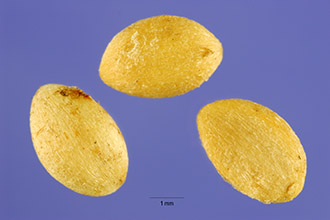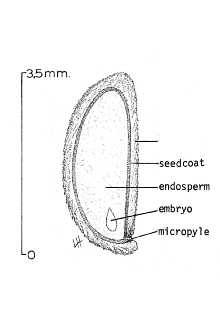Common Snowberry
Scientific Name: Symphoricarpos albus (L.) S.F. Blake

| General Information | |
|---|---|
| Usda Symbol | SYAL |
| Group | Dicot |
| Life Cycle | Perennial |
| Growth Habits | ShrubSubshrub, |
| Native Locations | SYAL |
Plant Guide
Alternate Names
White coralberry, common snowberry , Use soil moisture sensors to measure the soil moisture of Common Snowberry.
Uses
Ethnobotanic: Some southern groups made brooms out of the branches and the Gitksan hollowed out the twigs to make pipe-stems (MacKinnon, Pojar, & Coupe´ 1992). One or two of the berries were eaten by the Stl’atl’imx to settle the stomach after too much fatty food (Pojar & MacKinnon 1994). An infusion of the fruit was used as eyewash for sore eyes and the berries were rubbed on the skin as treatment for burns, rashes, and sores (Moerman 1998). A decoction of the roots and stems was used in the treatment of the inability to urinate, venereal diseases, tuberculosis and the fevers associated with teething sickness (Ibid.). A tea made from the roots of this species was used to clear up afterbirth (Fielder 1975). Wildlife: Snowberry is an important browse for many types of livestock and wildlife. It is important for shelter and food for various birds and small mammals.
Status
Please consult the Plants Web site and your State Department of Natural Resources for this plant’s current status, such as, state noxious status and wetland indicator values. Brother Alfred Brousseau © Saint Mary's College @ CalPhotos
Description
General: Honeysuckle family (Caprifoliaceae). Snowberry (Symphoricarpos albus) is a shrub or small tree that grows up to six meters tall. The leaves are large, opposite, divided into five to seven leaflets, and toothed or irregularly lobed. The fruits are white, berry like drupes, and one to one and a half centimeters in diameter. The flowers are small, white to creamy, with a strong unpleasant odor; numerous in a rounded or pyramidal parasol-like cluster (Pojar & MacKinnon 1994); blooming from mid May to July. The fruits are roundish, dull-white berries about 3/8 inch in diameter, soon becoming blackish, ripening August or September (Grimm 1993). Distribution: Snowberry inhabits slopes and valley bottoms of the foothills of the Coast Ranges, the Sierra Nevada, and the mountains of southern California (McMinn 1939). It extends northward to British Columbia and eastward to Pennsylvania and the New England states (Ibid.). For current distribution, please consult the Plant profile page for this species on the PLANTS Web site.
Adaptation
Symphoricarpos albus is found along stream banks, in swampy thickets, moist clearings and open forests at sea level to middle elevations (Pojar & MacKinnon 1994). It tolerates soil types but grows best in heavy clay soils. Snowberry grows well in sun or shade.
Establishment
Propagation by Seed: Symphoricarpos albus seeds are best sown in the fall after maturity. Dormancy of this species is caused by hard seed coat and immature embryo, which can be broken by stratification in sand and peat for 90 days at 77º, plus 180 days at 41ºF. When the seedlings are large enough to handle, place them into individual pots and grow them in the greenhouse for their first winter. Plant seedlings into their permanent positions in late spring or early summer.
Management
Snowberry fruit contains low concentrations of a bitter principle, saponin, which foams in water. It is very poorly absorbed by the body and can be broken down by thoroughly cooking the fruit. Saponin is much more toxic to some creatures, such as fish, if eaten in large quantities. Cultivars, Improved and Selected Materials (and area of origin) Commonly available through native plant nurseries, except in the south. Contact your local Natural Resources Conservation Service (formerly Soil Conservation Service) office for more information. Look in the phone book under ”United States Government.” The Natural Resources
Conservation
Service will be listed under the subheading “Department of Agriculture.”
Fact Sheet
Alternative Names
Common Alternate Names: white coralberry, common snowberry Scientific Alternate Names: None
Uses
Ethnobotanic: Some southern groups made brooms out of the branches and the Gitksan hollowed out the twigs to make pipe-stems (MacKinnon, Pojar, & Coupe´ 1992). One or two of the berries were eaten by the Stl’atl’imx to settle the stomach after too much fatty food (Pojar & MacKinnon 1994). An infusion of the fruit was used as eyewash for sore eyes and the berries were rubbed on the skin as treatment for burns, rashes, and sores (Moerman 1998). A decoction of the roots and stems was used in the treatment of the inability to urinate, venereal diseases, tuberculosis and the fevers associated with teething sickness (Ibid.). A tea made from the roots of this species was used to clear up afterbirth (Fielder 1975). Wildlife: Snowberry is an important browse for many types of livestock and wildlife. It is important for shelter and food for various birds and small mammals.
Status
Please consult the Plants Web site and your State Department of Natural Resources for this plant’s current status, such as, state noxious status and wetland indicator values.
Description
General: Honeysuckle family (Caprifoliaceae). Snowberry (Symphoricarpos albus) is a shrub or small tree that grows up to six meters tall. The leaves are large, opposite, divided into five to seven leaflets, and toothed or irregularly lobed. The fruits are white, berry like drupes, and one to one and a half centimeters in diameter. The flowers are small, white to creamy, with a strong unpleasant odor; numerous in a rounded or pyramidal parasol-like cluster (Pojar & MacKinnon 1994); blooming from mid May to July. The fruits are roundish, dull-white berries about 3/8 inch in diameter, soon becoming blackish, ripening August or September (Grimm 1993). Distribution: Snowberry inhabits slopes and valley bottoms of the foothills of the Coast Ranges, the Sierra Nevada, and the mountains of southern California (McMinn 1939). It extends northward to British Columbia and eastward to Pennsylvania and the New England states (Ibid.). For current distribution, please consult the Plant profile page for this species on the PLANTS Web site.
Adaptation
Symphoricarpos albus is found along stream banks, in swampy thickets, moist clearings and open forests at sea level to middle elevations (Pojar & MacKinnon 1994). It tolerates soil types but grows best in heavy clay soils. Snowberry grows well in sun or shade.
Establishment
Propagation by Seed: Symphoricarpos albus seeds are best sown in the fall after maturity. Dormancy of this species is caused by hard seed coat and immature embryo, which can be broken by stratification in sand and peat for 90 days at 77º, plus 180 days at 41ºF. When the seedlings are large enough to handle, place them into individual pots and grow them in the greenhouse for their first winter. Plant seedlings into their permanent positions in late spring or early summer.
Management
Management Snowberry fruit contains low concentrations of a bitter principle, saponin, which foams in water. It is very poorly absorbed by the body and can be broken down by thoroughly cooking the fruit. Saponin is much more toxic to some creatures, such as fish, if eaten in large quantities. Cultivars, Improved and Selected Materials (and area of origin) Commonly available through native plant nurseries, except in the south.
References
Carter, J.C. 1997. Trees and shrubs of New Mexico. Mimbres Publishing. Dirr, M.A. & M.W. Heuser 1987. The reference manual of woody plant propagation. Varsity Press, Athens, Georgia. Fielder, M. 1975. Plant medicine and folklore. Winchester Press, New York, New York. Gleason, H.A. & A. Cronquist 1991. Manual of vascular plants of northeastern United States and Canada. 2nd ed. New York Botanical Garden, New York, New York. Grimm, W.C. 1993. The illustrated book of wildflowers and shrubs. Stackpole Books, Mechanisburb, Pennsylvania. Guard, J.B. 1995. Wetland plants of Oregon and Washington. Lone Pine Publishing, Redmond, Washington. Hickman, J.C. 1993. The Jepson manual: higher plants of California. University of California press, Berkeley, California. MacKinnon, A, J. Pojar, & R. Coupe´ 1992. Plants of northern British Columbia. Lone Pine Publishing, Redmond, Washington. McMinn, H.E. 1939. An illustarted manual of California shrubs. University of California Press, Berkeley, California. Moerman, D. 1998. Native American ethnobotany. Timber Press, Portland, Oregon. Pojar, J. & A. MacKinnon 1994. Plants of the Pacific Northwest Coast: Washington, Oregon, British Columbia, and Alaska. Lone Pine Publishing, Redmond, Washington. Vines, R.A. 1960. Trees, shrubs and woody vines of the southwest. University of Texas Press, Austin, Press. Prepared By: Jammie Favorite Formerly, USDA, NRCS, National Plant Data Center Baton Rouge, Louisiana
Species Coordinator
Lincoln M, Moore Formerly USDA, NRCS, National Plant Data Center Baton Rouge, Louisiana , Use soil moisture sensors to measure the soil moisture of Common Snowberry.
Plant Traits
Growth Requirements
| Temperature, Minimum (°F) | -38 |
|---|---|
| Adapted to Coarse Textured Soils | Yes |
| Adapted to Fine Textured Soils | Yes |
| Adapted to Medium Textured Soils | Yes |
| Anaerobic Tolerance | None |
| CaCO3 Tolerance | High |
| Cold Stratification Required | Yes |
| Drought Tolerance | High |
| Fertility Requirement | Medium |
| Fire Tolerance | High |
| Frost Free Days, Minimum | 150 |
| Hedge Tolerance | Low |
| Moisture Use | Medium |
| pH, Maximum | 7.8 |
| pH, Minimum | 6.0 |
| Planting Density per Acre, Maxim | 1700 |
| Planting Density per Acre, Minim | 1200 |
| Precipitation, Maximum | 45 |
| Precipitation, Minimum | 12 |
| Root Depth, Minimum (inches) | 18 |
| Salinity Tolerance | Medium |
| Shade Tolerance | Intolerant |
Morphology/Physiology
| Bloat | None |
|---|---|
| Toxicity | Slight |
| Resprout Ability | Yes |
| Shape and Orientation | Rounded |
| Active Growth Period | Spring and Summer |
| C:N Ratio | Medium |
| Coppice Potential | No |
| Fall Conspicuous | No |
| Fire Resistant | No |
| Flower Color | White |
| Flower Conspicuous | No |
| Foliage Color | Green |
| Foliage Porosity Summer | Dense |
| Foliage Porosity Winter | Moderate |
| Foliage Texture | Medium |
| Fruit/Seed Conspicuous | Yes |
| Nitrogen Fixation | None |
| Low Growing Grass | No |
| Lifespan | Long |
| Leaf Retention | No |
| Known Allelopath | No |
| Height, Mature (feet) | 3.0 |
| Height at 20 Years, Maximum (fee | 3 |
| Growth Rate | Moderate |
| Growth Form | Rhizomatous |
| Fruit/Seed Color | White |
Reproduction
| Vegetative Spread Rate | Moderate |
|---|---|
| Small Grain | No |
| Seedling Vigor | Medium |
| Seed Spread Rate | Slow |
| Fruit/Seed Period End | Fall |
| Seed per Pound | 76029 |
| Propagated by Tubers | No |
| Propagated by Sprigs | No |
| Propagated by Sod | No |
| Propagated by Seed | No |
| Propagated by Corm | No |
| Propagated by Container | Yes |
| Propagated by Bulb | No |
| Propagated by Bare Root | Yes |
| Fruit/Seed Persistence | Yes |
| Fruit/Seed Period Begin | Summer |
| Fruit/Seed Abundance | Medium |
| Commercial Availability | Routinely Available |
| Bloom Period | Early Summer |
| Propagated by Cuttings | No |
Suitability/Use
| Veneer Product | No |
|---|---|
| Pulpwood Product | No |
| Protein Potential | Low |
| Post Product | No |
| Palatable Human | No |
| Palatable Graze Animal | Low |
| Palatable Browse Animal | High |
| Nursery Stock Product | Yes |
| Naval Store Product | No |
| Lumber Product | No |
| Fodder Product | No |
| Christmas Tree Product | No |
| Berry/Nut/Seed Product | No |

